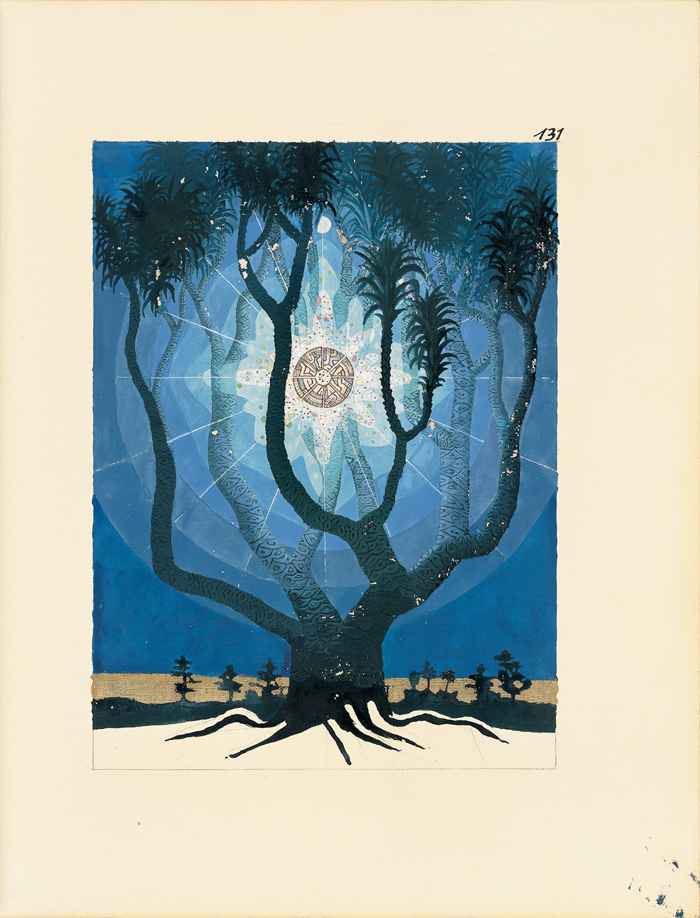
C.G. Jung, illustration from The Red Book. © Foundation of the works of C.G. Jung. Reprinted with permission of the publisher, W.W. Norton & Company, 2009.
The years, of which I have spoken to you, when I pursued the inner images, were the most important time of my life. Everything else is to be derived from this. It began at that time, and the later details hardly matter any more. My entire life consisted in elaborating what had burst forth from the unconscious and flooded me like an enigmatic stream and threatened to break me. That was the stuff and material for more than only one life. Everything later was merely the outer classification, the scientific elaboration, and the integration into life. But the numinous beginning, which contained everything, was then. -C.G. Jung, 19571
In the Kunstmuseum Basel hangs what must be one of the most graphic and unsettling pictures in the Western canon, Hans Holbein’s Dead Christ in the Tomb (1521). Confined to a shallow claustrophobic space (the limewood panel on which it is painted measures out at 12 x 78 3/4 inches) the body of the dead Christ lies in a shallow niche hacked out of a raw rock wall, rather like a cubiculum in an early Christian catacomb. The body is horrendously emaciated and stiffened by rigor; the face and hands are gray, bruised and battered; the wounds that puncture and tear the skin are painful even to look at. There is no trace of the immanent transcendence that would mark the body as that of the soon-to-be-risen Christ. There is no trace, it might be argued, even of a faith in that transcendence as “a thing unseen” (as Saint Paul says in Hebrews 11:1). In short, as the psychoanalyst and literary critic Julia Kristeva has suggested, Holbein’s Dead Christ may literally be a painting beyond belief: an icon of the inability to sustain belief at the very heart of the Christian mythos.2

Hans Holbein the younger, The Dead Christ, 1521. Tempera on panel, 12 x 78 3/4 in. Courtesy Kunstmuseum, Basel, Switzerland/the Bridgeman Art Library.
I wonder if Holbein’s picture would have struck the young C.G. Jung in that way as he strolled through the Kunstmuseum in his youth. Although he was the son of a Swiss Reformed pastor, he felt nothing at the moment of his first Holy Communion, only “an absence of God and no religion,” in a place where there “was no life…but [only] death.”3Later he became a medical student much impressed with the gnomic proclamation of Nietzsche’s Zarathustra that “God is dead.”4 Eventually he settled down professionally as a diligent psychoanalyst who sought the common psychic substrate that underlay both mental illness and our own less gravid emotional problems.
I would like to think so. Yet, following a series of apocalyptic dreams and visions that occurred during the period of October 1913-July 1914, and culminating with a profound sense of psychic release prompted by the outbreak of World War I, Jung undertook the compilation and composition of a magisterial work of self-analysis and self-definition. It begins, under the heading “The Way of What Is to Come,” with a Latin quotation from Isaiah 53:1-4: “Isaias dixit: quis credidit auditori nostro…” (Isaiah said: Who hath believed our report? And to whom is the arm of the Lord revealed?)5 That work, the so-called Red Book or Liber Novus, engaged the author’s attention at intervals during the period 1914-1930, and is an extraordinary artifact that must rank with Saint Augustine’s Confessions as spiritual autobiography and with the Scivias of Hildegard of Bingen as a record of visionary experience.6
Not surprisingly, given the painful circumstances of its inception, the visionary power of its narrative, and its eccentricity as an object, The Red Book was very closely guarded by its author during his own lifetime; and following his death in 1961, it reposed for almost half a century in a Swiss bank vault. Finally, however, in 2009, The Red Book: Liber Novus at last became available in an extraordinary facsimile edition, published by W.W. Norton & Company in association with the Foundation of the Works of C.G. Jung in Zurich, Switzerland. Although such an ambitious undertaking is perforce very much a team effort, the project proceeded under the editorship of Sonu Shamdasani, Acting Director at the Wellcome Trust Centre for the History of Medicine at University College, London.7Publication of the facsimile was followed in Los Angeles by a small but tightly focused exhibition at the Hammer Museum, which ran from April to June 2010.
As for the facsimile itself, one need only say that the ambition of the project was beautifully matched by the skill of its execution. Even in reproduction, the manuscript is magnificent. The illuminations appear to glow with an otherworldly intensity. They seem at once to be essentially of their own time, embedded in deep historical time, and existing in a world eternal and outside of time. They belong simultaneously to a medieval and modern visual culture, echoing (among many possible touchstones) both the Beatus Apocalypse Commentaries of Mozarabic Spain (tenth century) and the work of the Vienna Secession.8There might even be a touch of DADA.9
All this magnificence is anchored by an exhaustive critical apparatus: a capacious introduction; a complete translation of Jung’s text with copious commentary, references, and cross-references; and several appendices with further editorial commentary and appropriate illustrations. Professor Shamdasani and his editorial team have expended an enormously fruitful effort, which has been sumptuously matched by the labors of the craftsmen at Norton. In short: it’s a triumph of contemporary book production, an exquisite artifact, and an endlessly illuminating (if occasionally also frustrating) read.
In some ways, Liber Novus is difficult even to describe adequately. It is a large (11 1/2 x 14 1/4 inch) elaborately illuminated manuscript comprising two sections of unequal length. The text, in Latin and German, was first composed and edited by Jung from a variety of sources, and then copied out by him onto the sheets that were later assembled into a red leather binding. The text is rubricated as though it were ecclesiastical in nature, supplied with numerous decorated initials, and brilliantly illuminated by the author in a strong yet idiosyncratic style. A large number of full-page illuminations reveal Jung to have been an artist of considerable talent and extraordinary imaginative power. It is tempting to refer to the book as the last great work of medieval art.
But that is only to look at the book as a physical artifact. Eccentric and brilliant as it may be in those terms, Liber Novus provides as well a kind of triple psychological narrative that makes it, so far as I know, utterly unique. It is, first of all, the visionary chronicle of Jung’s own process of individuation, literally his coming-into-being as a fully integrated or, in Jung’s own terms, individuated human being. Second, that chronicle provides a template for the process of individuation in general, the story of human psychogenesis both across time or through history, and within the evolution or unfolding of every individual human existence. Finally, that narrative of individuation is embedded within a fully articulated cosmogony, the literal evocation of a cosmos within which the insights of religion and mythology, as well as those of anthropology and psychology, are cast in a relationship of mutually reinforcing and transforming tension (in short, a dialectic) that provides the nexus within which modern man comes to realize the fact of his individual and cultural being.
Those facts alone point to one of the signal differences between Jung and his elder and mentor, Sigmund Freud. For the thorough-going materialist Freud, that so-called “oceanic feeling” of spiritual oneness to which the Viennese analyst alluded on several occasions was so remote from his own experience that he failed even to hear the waves breaking against the shore.10 For Jung, the spiritual aspect of human existence for which the ocean provided such a powerful metaphor came to take a central, almost a defining role. As one who would wholeheartedly embrace Jung’s position, but whose personal experience comes much closer to that of Freud, I find myself at once fascinated and bedeviled by both of their positions.
Indeed, if Liber Novus demonstrates nothing else, it provides an absolute confirmation of the admission contained in a letter from Jung to Freud and dated November 26, 1912. “I am glad that we were able to meet [at the psychoanalytic conference] in Munich, as this was the first time I have really understood you. I realized how different I am from you.”11 Different enough, apparently, that “[T]his realization will be enough to effect a radical change in my whole attitude.” Different enough that on January 6, 1913, Jung “accede[d] to… [Freud’s] wish that we abandon our personal relations,” adding simply but significantly Hamlet’s dying assertion that “The rest is silence.”12
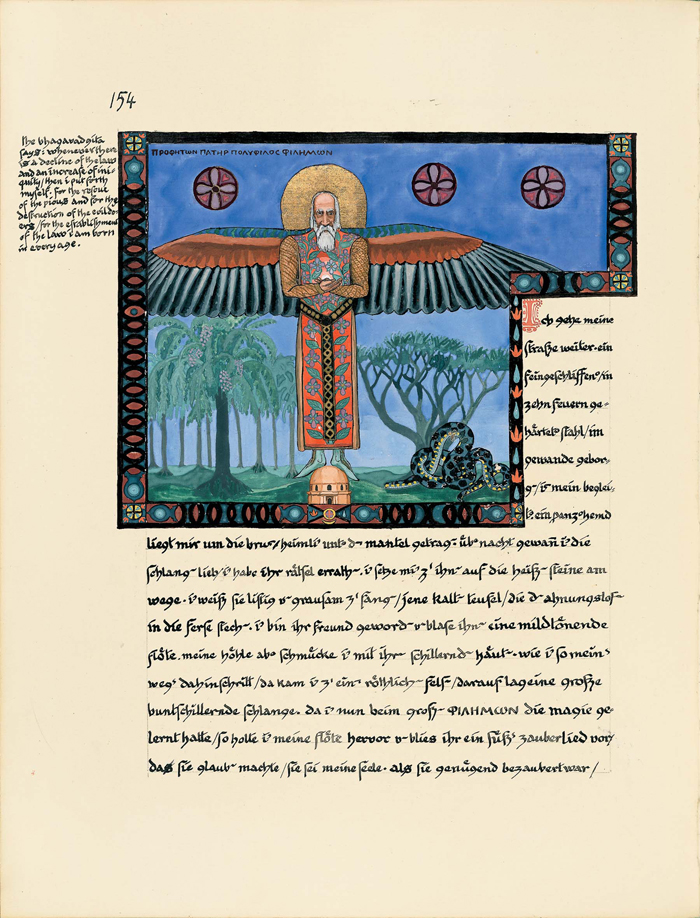
C.G. Jung, illustration from The Red Book. © Foundation of the works of C.G. Jung. Reprinted with permission of the publisher, W.W. Norton & Company, 2009.
The final break between Freud and Jung, ostensibly over theoretical disagreements centered on Jung’s revisions of Freud’s concept of the libido, was clearly also bound up with some sort of father-son or master-pupil struggle. That struggle, both personal and professional, prefaced the onset of Jung’s apocalyptic dreams, which in turn led to the initiation of serious work on the Liber Novus project. In Jung’s own account, the final catalyst in this process was the outbreak of World War I, which, Jung later maintained, his dreams had prophetically foretold. Thus Liber Novus is inextricably bound up with both the most significant rift in the nascent psychoanalytic movement, and also the collapse of a world order that itself rested on a fragile vestige of (Victorian) familial ties destined to be swept away on the violent tide of expansive nationalism.13
Almost as if to escape consciously the Stahlgewittern (storms of steel) of that all-too-real apocalypse, Jung then began his pursuit of those “inner images,” searching always for a vision of that “numinous beginning, which contained everything.”14 Today, just over eighty years after the end of that pursuit, one might easily and rather glibly ask, “So what? Of what use are Jung’s inner images to me?” Despite my rather deprecatory tone, I intend this as a serious question. And I intend to suggest an equally serious answer to it. But first allow me a short digression.
Despite the pre-publication hype, which confidently asserted that The Red Book is “thought to be the most important unpublished work in the history of psychology,”15 it is certainly the case that the twentieth was a Freudian century.It is the Freudian text, with its emphasis on sexuality and repression, and its “thoroughly materialistic, immanentist, and disillusioned account” of civilization that has provoked the kind of response (laudatory and condemnatory) that has insured Freud a place–along with Darwin and Marx– among the post-Enlightenment triumvirate whose massive shadows lay across the landscape of the late nineteenth and twentieth centuries.16
It is not so much that Freud has won the struggle that initially engaged his and Jung’s energies, although it is true that Jung’s ideas (for example his notion of the complex, which many laymen undoubtedly associate with Freud) are more regularly encountered in introductory psychology texts than in the curricula implemented for the training of professionals in psychiatric analysis.17 Advances in neuroscience and psychopharmacology (among numerous other scientific and medical disciplines), as well as the proliferation of competing therapeutic models, have left both Freud and Jung behind as models to be slavishly followed in practical analytical work. Their systems of psychic and cultural functioning, as well as their therapeutic strategies, have essentially become texts, metaphors–one is almost tempted to say with Freud “illusions”–of psyche and society, individual and culture, that have become embedded (along with those of Darwin and Marx) in a vastly larger cultural discourse in which they function as both roadmaps to be followed and topographies to be traversed.18
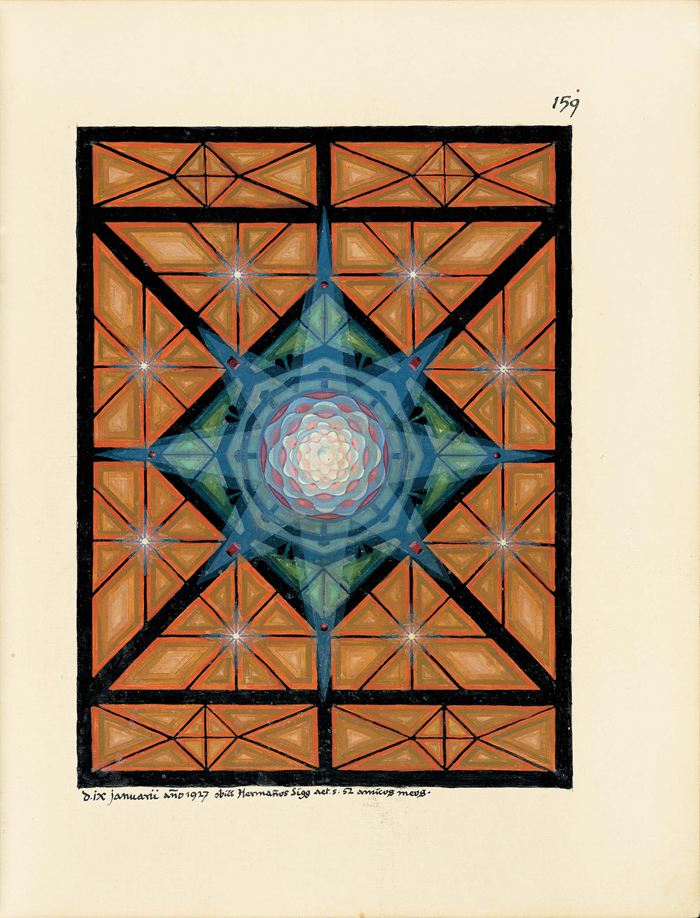
C.G. Jung, illustration from The Red Book. © Foundation of the works of C.G. Jung. Reprinted with permission of the publisher, W.W. Norton & Company, 2009.
All of this is unquestionably true of Freud. Of Jung, maybe not so much. And it is the “why” behind this “not so much” that points toward the answer to my earlier question, an answer that begins with a striking if apparently tangential image, which inserts the figure of Saint Francis preaching to the birds into The Cabinet of Doctor Caligari:
Binswanger noted with chagrin that although Warburg had come to Bellevue to undergo “the talking cure,” [a Freudian psychoanalysis] he remained singularly uncommunicative–with people. He did, however, speak with what he called his Seelentierchen, his “tiny soulful animals”: the butterflies and moths that were the frequent companions of his lonely hours. Binswanger first had a real glimpse of what, in fact, was secretly troubling Warburg one evening almost three weeks after his patient’s arrival. Walking by an open window, Binswanger happened to overhear Warburg telling one of his flitting friends of the terror that gripped him during the then-raging First World War.19
Note here that the “Warburg” mentioned in the quoted passage is Aby Warburg (1866-1929), perhaps the single most important of the founding fathers of the discipline of cultural history, and historian of the Nachleben (afterlife) of the classical tradition, especially that of the pagan past in its relation to the emergence of modernity. “Binswanger” is Ludwig Binswanger, an early practitioner of psychoanalysis, whose prestigious Bellevue sanitarium, located at Kreuzlingen, Switzerland, treated a number of high profile patients during this period.20
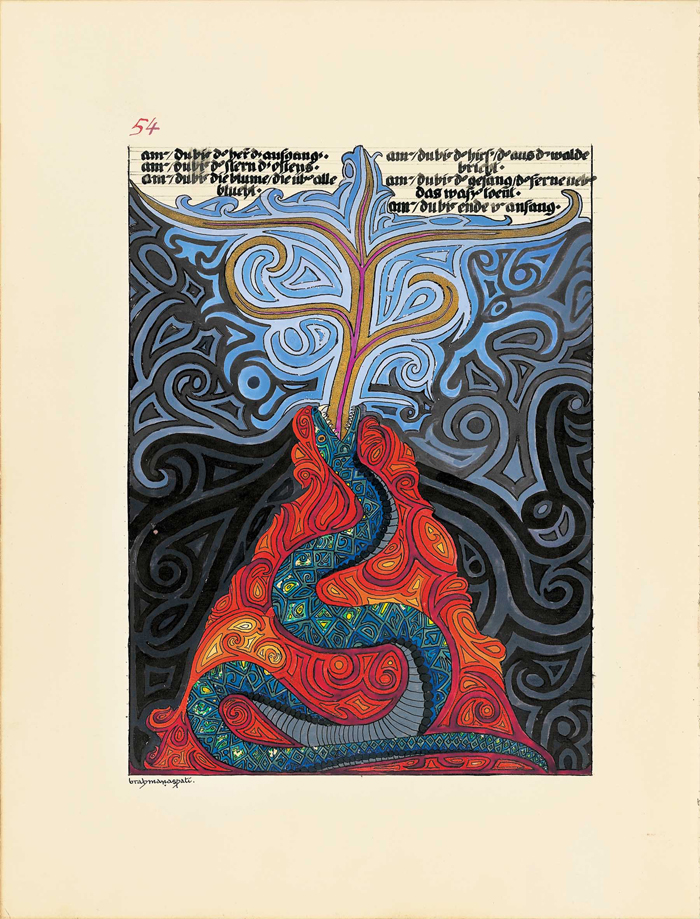
C.G. Jung, illustration from The Red Book. © Foundation of the works of C.G. Jung. Reprinted with permission of the publisher, W.W. Norton & Company, 2009.
Scion of a wealthy German banking family, Aby Warburg was already an important art historian when he suffered a severe and debilitating breakdown in 1918, which in turn led to his institutionalization under Binswanger’s care.21 He remained institutionalized until 1924; but his eventual release was in fact predicated on the sanity “proof text” of an illustrated lecture he delivered at Bellevue in 1923. “Images from the Region of the Pueblo Indians of North America” was a brilliant analysis of a Pueblo ceremonial dance, as well as a stunning demonstration of his own working method and a reverberant echo of the same profound and prophetic disquiet with the world of modernity that also animated Freud and Jung.
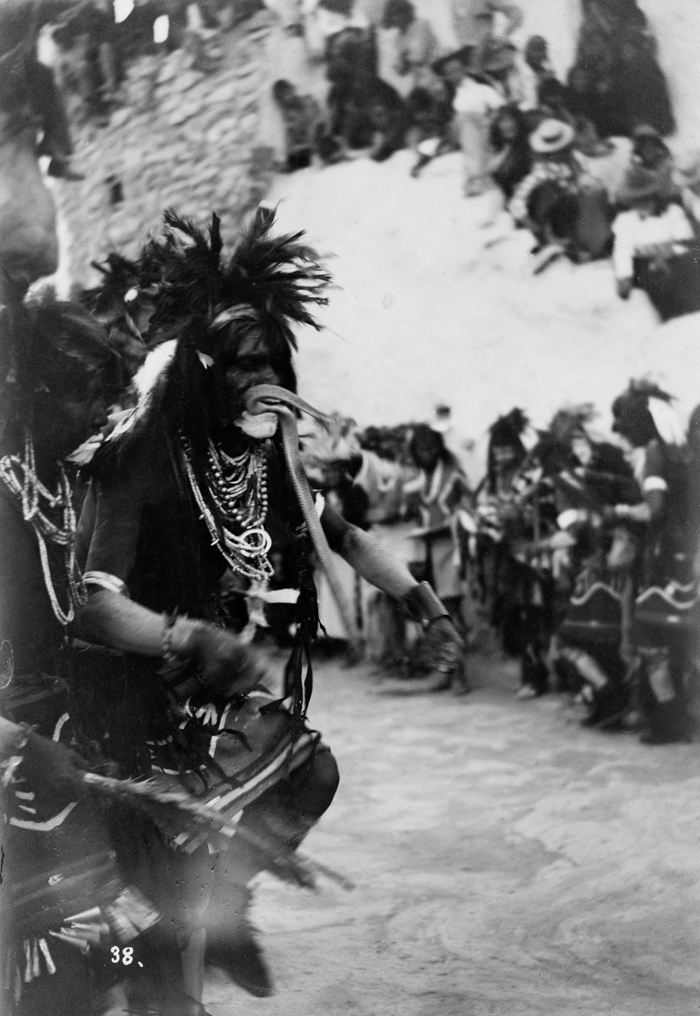
Hartwell & Hamaker, Hopi Snake Priest with snake in his mouth in the Hopi Snake Dance, c. 1899. Hartwell & Hamaker, Phoenix, Ariz.
Having described in considerable detail the dance with live serpents performed by the Pueblo inhabitants of Oraibi and Walpi (the most remote pueblos, and hence, for Warburg, those putatively the least subject to European influences), Warburg embeds that description within an interpretive matrix that situates the serpent within biblical, antique, and Native American traditions. He argues that the serpent is the quintessential liminal being, both dangerous and life giving, both chthonic and heavenly, associated, for example, with the Crucifixion on the one hand and the lightning that brings rain on the other. In the case of the Pueblo Indians, the serpent indicates “the passage from a symbolism whose efficacy proceeds directly from the body [of the snake] and the hand [of the dancer] to one that unfolds only in thought.”22 This is true since “[t]he Indians actually clutch their serpents and treat them as living agents that generate lightning at the same time [my emphasis] that they represent lightning.”23
As Warburg makes clear, he has no doubts at all that this symbolic manifold is universal, an aspect of human culture tout court. In fact, he continues, “We might say that where helpless human suffering searches for redemption, the serpent as an image and agent of causality cannot be far away.”24 Compare this to the Jung of The Red Book, where the serpent appears on numerous occasions, but never to more brilliant effect than in the extraordinary narrative and dialog with the “great iridescent [and poisonous] serpent” that follows immediately on the equally extraordinary Philemon illustration.25 In the same way that one of Warburg’s Indians “takes the serpent in his mouth to bring about an actual union of the serpent with the masked figure” [that is, the dancer],26 so Jung’s magical flute player enchants the serpent into a belief in their union, in order to discover that, if only symbolically, “the becoming of the soul follows a serpentine path.”27 As Jung describes it, his relationship with serpents in general is nothing if not liminal: “I know how to catch them cunningly and cruelly, those cold devils that prick the heel of the unsuspecting. I became their friend and played a softly toned flute. But I decorate my cave with their dazzling skins.”28Later, “[a]s I went on my way, I came to a red rock on which a great iridescent serpent lay….I took out my flute again and played a sweet magical song to make her believe that she was my soul.”29 Or perhaps not only symbolically, since the flute player responds to this serpentine revelation in a suitably serpentine fashion, “I want to lie in the sun on this warm stone for a while. Perhaps the sun will incubate me.”30
It seems eminently arguable, at least on the basis of this example, that Jung and Warburg share a deep and abiding faith in the underlying unity of human culture and of its development along parallel lines both across space and through time. We might describe this sense as embodying a notion of “deep psychology” on Jung’s part, and perhaps a kind of “deep anthropology” on Warburg’s. This was not especially a concern shared by Freud, and to many contemporary (and not so contemporary) observers it must appear archaic, ruled out of court by the arbitrary character of the linguistic sign as defined initially by Saussure, which in and of itself is taken to disrupt any appeal to an idea of “natural meaning” (for example, that residing in some sort of “collective unconscious”) since language is taken to define the necessary horizon within which any (arbitrary) cultural meaning must be formulated and disseminated.31
Certainly no one would argue that either Jung or Warburg, or Freud, or Levi-Strauss, for that matter, had a firm grasp on the actual mechanism by which human culture originally came into being and cultural “meanings” began to be articulated and disseminated. Recent work in paleoanthropology, cerebral anatomy and brain biochemistry, developmental genetics, and any number of other arcane disciplines suggests that this understanding is yet some way in the future. It is by no means certain that the horizon of meaning will continue to coincide with some arbitrary linguistic horizon; and it may well be that, in some way he could never have imagined, Immanuel Kant’s philosophical argument that at least certain structures of meaning inhere in the structure of “mind” itself (or the numinous electrical fluctuations within the brain) will prove out in fact as well as in theory. If that should indeed come to pass, then one could easily understand a deep and wordless relationship between the Pueblo dancer desiring to become one with the agent and symbol of the lightning that heralds life-giving rain, and the soul of Jung’s wandering flute-player who follows his serpentine path to the warmth of the sun as it falls on a stone.
That being the case, perhaps one might just as well lecture the moths and the butterflies.
More seriously, I think there is a methodological lesson to be learned here. Phrased as an answer to the question posed above, it might be put like this: those “inner images” that Jung pursued so assiduously and described so brilliantly in The Red Book should serve as a constant reminder of the breadth and depth of the world of cultural meanings within which we all move; and as a parallel warning against the twin dangers of overly broad or overly narrow looking, reading, and interpreting. Certainly, every cultural artifact has its own specificity, its own nuance, its own particularity of being and meaning. It is not simply an instance of a type or an individual within a genus or a species. But that particularity of meaning has also an almost infinite resonance and an almost infinite ability to combine with other equally resonant meanings in endlessly complex chains of signification.32 The world of postmodernity may have changed the (arbitrary) rules according to which those combinations and re-combinations can be articulated and understood–but it cannot dissolve the humanity grounded in those acts of making and understanding.
In the case of Jung’s Red Book, that “act of making” was prodigious, indeed cosmogenic in its scope, as Jung aimed at nothing less than the evocation of a dynamic cosmos within which the process of his own individuation could unfold toward its climax. Even so, the author himself felt that effort in the last analysis to have been incomplete–indeed, the ending of the text leaves one with the feeling of standing on a threshold, as if all that had gone before was simply the construction of a foundation on which to effect the real work, the actual building. Says Jung, “An opus is needed, that one can squander decades on, and do it out of necessity.”33
And why is this further effort needed? Because as he says: “My I, you are a barbarian….You should be the vessel and the womb of life, therefore I shall purify you.”34Although Jung’s language here is embedded within a quite idiosyncratic “medieval” rhetoric, the ultimate source of these formulations is clear: they derive from alchemy, another of Jung’s great loves, and for him a vast repository of powerful and foundational cultural meanings.35The “opus” referred to is undoubtedly the great alchemical work, the transformation of base metal into gold, itself (in Jung’s esoteric reading of the alchemical literature) a metaphor for the purification of the alchemist’s own soul (“I shall purify you”) which, in a neat inversion of the traditional imagery that catches the move from “self” to “cosmos,” then becomes “the vessel and the womb of life.”
For Julia Kristeva, whose reading of Holbein, and of Christianity in general, is refracted through a Freudian lens, yet in all is deeply humane and sympathetic, the centrally important fact to which Holbein’s Dead Christ testifies is that of rupture, of caesura, of death, “[t]he break, brief as it might have been, in the bond linking Christ to his Father and to life.”36 And this is a fact central to the psychic life of every individual, at least as that life is conceived within a broadly Freudian tradition. “Thus, psychoanalysis identifies and relates as an indispensable condition for autonomy a series of splittings…; birth, weaning, separation, frustration, castration. Real, imaginary, or symbolic, those processes necessarily structure our individuation.” In addition, because Christianity structures itself around the most profound of all such separations, the self-alienation of “the absolute subject” (Christ) from his own Father, it arrogates to itself an enormous “cathartic power.”37
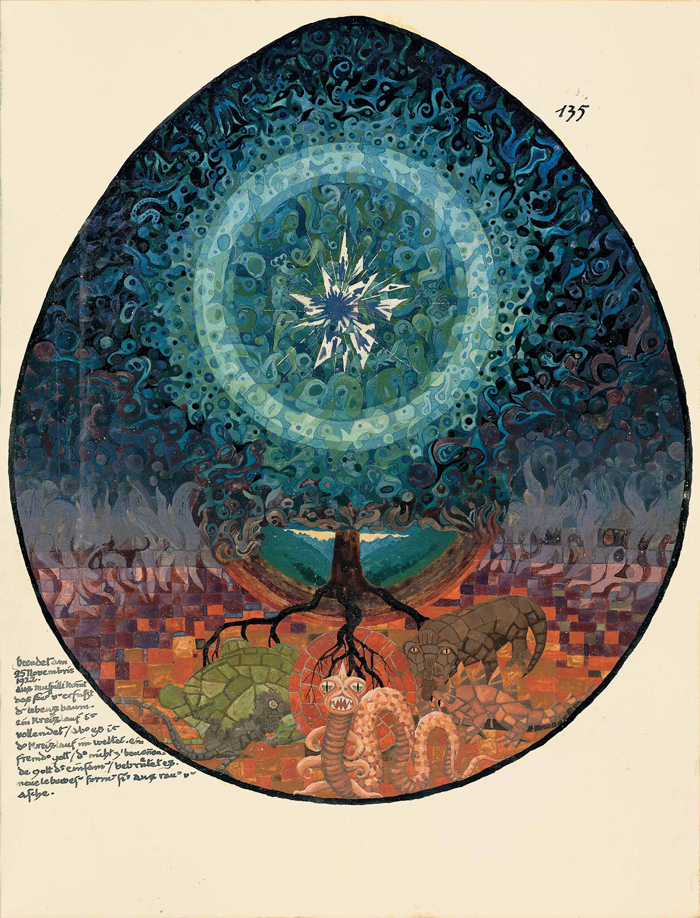
C.G. Jung, illustration from The Red Book. © Foundation of the works of C.G. Jung. Reprinted with permission of the publisher, W.W. Norton & Company, 2009.
And in fact, it is precisely this power that is realized by Holbein in a searing “minimalism” of form, and which, for Kristeva, is itself the supreme graphic “metaphor of [absolute] severance.”38 In its irony, in its tightrope-like balance along the infinitely thin line “between life and death, meaning and nonmeaning,” it is at first glance an apparently perfect metaphor to structure our lack of belief at the end of our Freudian century.39
But it is not at all Jung’s metaphor. Nor is it that of Warburg, for whom the significant relevant image is not the cave or the tomb, but its mouth.40 Or, as he says, using the image vocabulary of his Pueblo subjects, “We want to ascend to the roof of the worldhouse, our heads perched upwards” in adoration of the sun.41
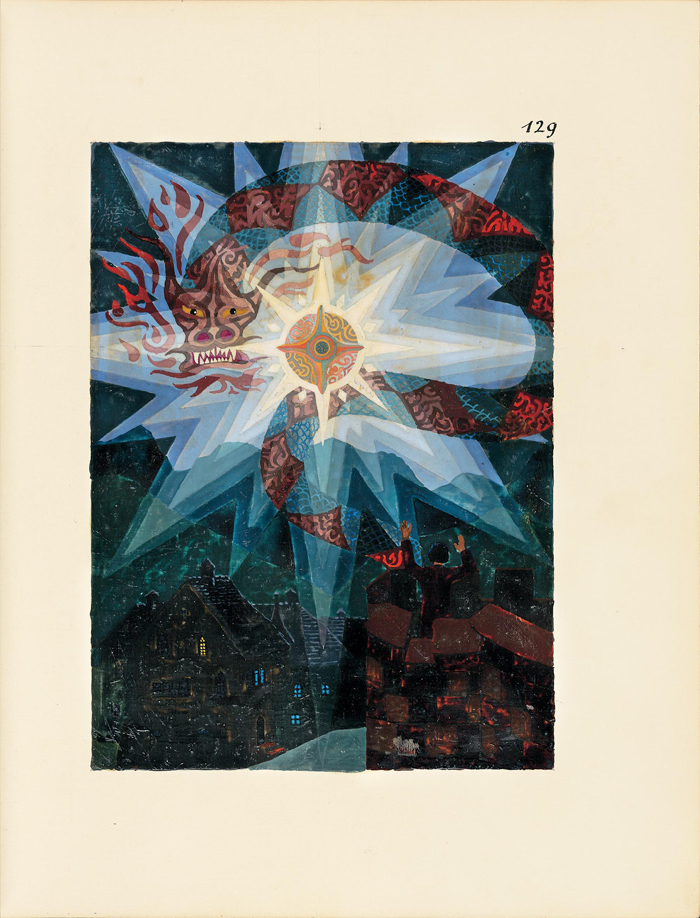
C.G. Jung, illustration from The Red Book. © Foundation of the works of C.G. Jung. Reprinted with permission of the publisher, W.W. Norton & Company, 2009.
Finally, returning at last to Jung, what of “the seeker of redemption” whose “relation…to the serpent develops…from coarse, sense-based interaction to its transcendence,” a transcendence that constitutes as well “the [whole] work of modern culture”? Jung’s answer to that question provides an image easily as stunning as that of Holbein.42Yet, except in its Christological reference, it is an image in every way the opposite of Holbein’s painting:
I saw the black serpent, as it wound itself upward around the wood of the cross. It crept into the body of the crucified and emerged again transformed from its mouth. It had become white. It wound itself around the head of the dead one like a diadem, and a light gleamed above his head, and the sun rose shining in the east. I stood and watched and was confused and a great weight burdened my soul. But the white bird that sat on my shoulder spoke to me: “Let it rain, let the wind blow, let the waters flow and the fire burn. Let everything have its development. Let becoming have its day.”43
It is up to us to decide if these two images are compatible or irreconcilable, whether Freud’s severance or Jung’s transfiguration holds the key to individuation. For myself, it is only in the ineffable gap between the two that I can sense the turning of that key in its lock, that I can apprehend the presence of a self, however dimly; and hence it is only there that the struggle for signification can then take place.
Glenn Harcourt received a PhD in the History of Art from the University of California, Berkeley. He currently lives and works in Los Angeles.
